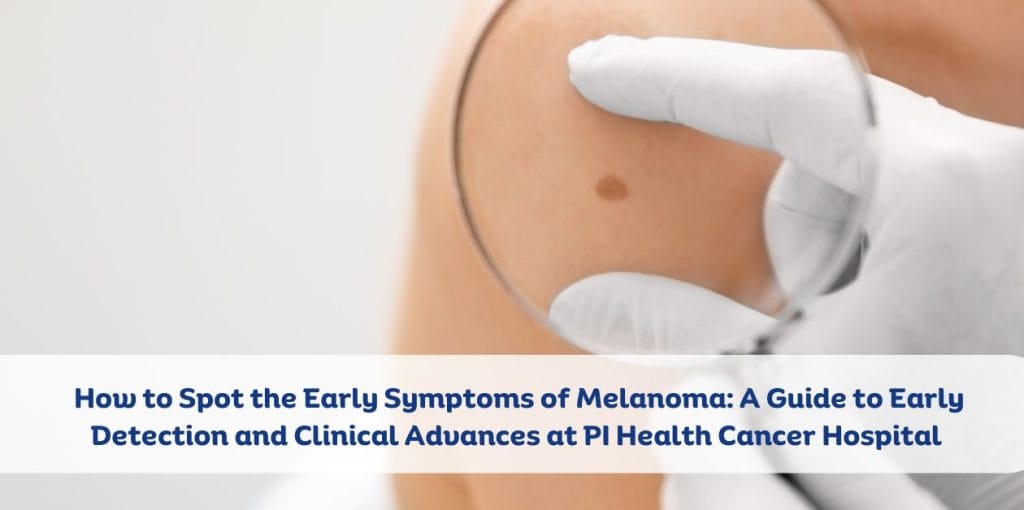Melanoma is a dangerous form of skin cancer that develops in the pigment-producing cells (melanocytes) of the skin. While it accounts for only a small percentage of all skin cancers, it is responsible for most skin cancer-related deaths. Early detection of melanoma is crucial for effective treatment and improved survival rates. In this blog, we will discuss how to spot the early symptoms of melanoma and explore groundbreaking clinical trials at PI Health Cancer Hospital that are advancing cancer detection and treatment methods.
Understanding Melanoma: What You Need to Know
Melanoma can develop in any part of the body, but it is mostly found on the skin. It is often caused by sun exposure, though it can also develop in areas that are not typically exposed to the sun. The cancer can spread quickly to other parts of the body if not caught early, making early detection critical.
Common Skin Cancer Symptoms to Watch Out For
Knowing how to identify the early symptoms of melanoma can be lifesaving. The key to detecting melanoma early lies in recognizing changes to the skin. Here are the most common signs to look for:
- Changes in Existing Moles: If you have a mole or birthmark that changes in shape, color, size, or texture, it could be a sign of melanoma. These changes may occur over weeks or months.
- New Growths on the Skin: Melanoma may also appear as a new, unusual growth on the skin, often asymmetrical, with uneven borders and varying colors.
- Itchiness, Bleeding, or Pain: If a mole or new growth becomes itchy, painful, or starts to bleed, it’s important to get it checked by a healthcare provider immediately.
- Color Changes: Melanomas often have multiple colors, such as black, brown, red, or even blue. This is different from benign moles, which tend to have a uniform color.
- Unusual Shape or Border: Unlike normal moles, which are typically round or oval with smooth borders, melanomas may have irregular, jagged, or scalloped borders.
- Changes in Size: A mole or growth that increases in size, especially if it is larger than the size of a pencil eraser, should be closely monitored.
The Role of Sun Exposure in Melanoma
While anyone can develop melanoma, exposure to ultraviolet (UV) radiation from the sun or tanning beds is one of the leading risk factors for developing skin cancer. UV rays damage the DNA in skin cells, leading to mutations that can result in cancer.
It’s important to note that melanoma can occur in areas that are not typically sun-exposed, so even those with limited sun exposure should remain vigilant about skin changes. Additionally, people with fair skin, a history of sunburns, or a family history of skin cancer are at a higher risk.
How PI Health Cancer Hospital is Advancing Melanoma Detection and Treatment
PI Health Cancer Hospital is at the forefront of melanoma research, conducting groundbreaking clinical trials that focus on innovative methods for early detection and treatment. These clinical trials are exploring new ways to identify melanoma at its earliest stages, allowing for more effective treatments and better outcomes for patients.
Clinical Trials Focused on Early Cancer Detection
One of the most exciting advancements in melanoma research at PI Health Cancer Hospital is the development of non-invasive screening technologies. These include innovative imaging techniques and molecular markers that can detect melanoma before visible symptoms appear. By identifying melanoma early, doctors can begin treatment while the cancer is still confined to the skin, significantly improving the patient’s prognosis.
Immunotherapy and Targeted Treatments
In addition to early detection, PI Health Cancer Hospital is also pioneering clinical trials that explore the use of immunotherapy and targeted treatments for melanoma. Immunotherapy works by boosting the body’s natural defenses to recognize and fight cancer cells, while targeted therapies aim at specific genes or proteins that drive cancer growth.
These treatments offer promising results for patients with advanced melanoma, and clinical trials are helping to refine their effectiveness.
Personalized Cancer Care
Another key focus of PI Health Cancer Hospital’s clinical trials is personalized cancer care. By analyzing each patient’s unique genetic makeup, doctors can tailor treatments to the individual’s specific needs. This personalized approach has shown tremendous success in improving treatment outcomes and minimizing side effects.
How to Protect Yourself from Melanoma
While early detection is essential, prevention is equally important. Here are some tips to help reduce your risk of developing melanoma:
- Use Sunscreen: Always apply broad-spectrum sunscreen with SPF 30 or higher, even on cloudy days. Reapply every two hours, or more frequently if swimming or sweating.
- Avoid Tanning Beds: Tanning beds expose the skin to elevated levels of UV radiation, increasing the risk of melanoma.
- Wear Protective Clothing: When spending time outdoors, wear protective clothing, wide-brimmed hats, and sunglasses to reduce sun exposure.
- Seek Shade: Avoid prolonged exposure to the sun, especially during peak hours (10 a.m. to 4 p.m.).
- Regular Skin Checks: Perform regular self-exams of your skin to check for any new or changing moles. Schedule annual checkups with a dermatologist for professional skin evaluations.
Conclusion
Melanoma is a serious skin cancer, but with early detection, it is highly treatable. Understanding the symptoms of melanoma and getting regular checkups is essential for protecting your health. Thanks to groundbreaking clinical trials at PI Health Cancer Hospital, early detection methods are becoming more advanced, leading to more effective treatments. By staying vigilant, protecting your skin, and seeking professional help when needed, you can take steps toward preventing and fighting melanoma.
If you notice any unusual changes in your skin or have concerns about your risk for melanoma, do not hesitate to contact a healthcare provider. Initial action can make all the difference.
FAQS
The first signs of melanoma include changes in the shape, color, or size of existing moles, or the appearance of new, unusual growths on the skin.
While sun exposure is a major risk factor for melanoma, it can also develop in areas not commonly exposed to the sun. Genetic factors and a family history of melanoma also play a role.
Early detection involves regular skin checks and recognizing any changes in moles or the appearance of new growths. Advanced imaging techniques and clinical trials at PI Health Cancer Hospital are also making early detection easier.
Yes, melanoma can spread (metastasize) to other parts of the body, including the lymph nodes, lungs, and liver. Early detection is critical for preventing metastasis.
The survival rate for melanoma is much higher when caught early. The five-year survival rate for localized melanoma (where the cancer has not spread) is around 99%.

Dr. A. Venugopal
Clinical Director & HOD Medical Oncology Senior Consultant Medical Oncologist & Hemato-Oncologist
About Author
Dr. A. Venugopal
MD (General Medicine), DM (Medical Oncology), MRCP – SCE Medical Oncology (UK), ECMO (Switzerland).
Dr A. Venugopal is One of the best medical oncologist and Hemato Oncologist in hyderabad, currently serving as the Head of the Department and Senior Medical Oncologist, Hemato Oncologist at Pi Health Cancer Hospital in Gachibowli, Hyderabad. He brings over 15 years of extensive experience in the field of Oncology.

